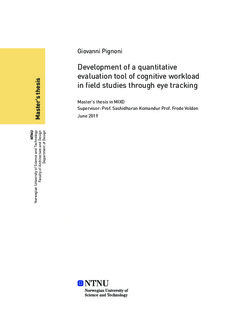| dc.description.abstract | Eye tracking is primarily intended as a mean for tracking the visual attention of an observer/operator. Still, eye tracking is also capable of recording a wider variety of psychophysical data, one of these is the trace effect of mental workload in the pupil diameter (dilatation of the pupil proportional to the level of cognitive workload). The effect of a varying visual stimulus, primarily luminance variations, on the pupil diameter has historically constrained studies on workload and pupillometry to controlled laboratory conditions, as, in field conditions, it cannot be accurately determined if the change in the pupil diameter of the subject is due to mental workload alone. Although it has been attempted to simultaneously account for the contribution of the change in pupil diameter due to luminance and mental workload, no instance has been found of an attempt to use video and luminance data dynamically to estimate the effect of the visual stimuli as it changes during a study session. Eye-tracking data will be used alongside the video feed of the field of view of the operator/observer and the data from an external luminance sensor to quantify the luminous flux from the point of view of the subject and estimate the expected pupil size. The estimated pupil size should then be used as a variating baseline to remove the effect of luminance on the pupil size and isolate the changes relative to mental workload. The newly developed methodology will be evaluated in both laboratory and field conditions such as tracking the experience of the navigator and his first officer in a high-speed marine craft of the Royal Norwegian Naval Academy alongside subjective data such as the widely used NASA-TLX for validation purposes. | |
